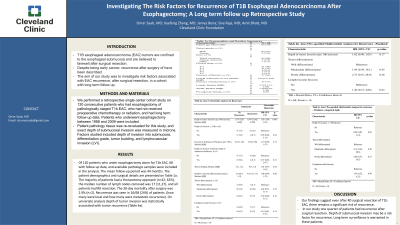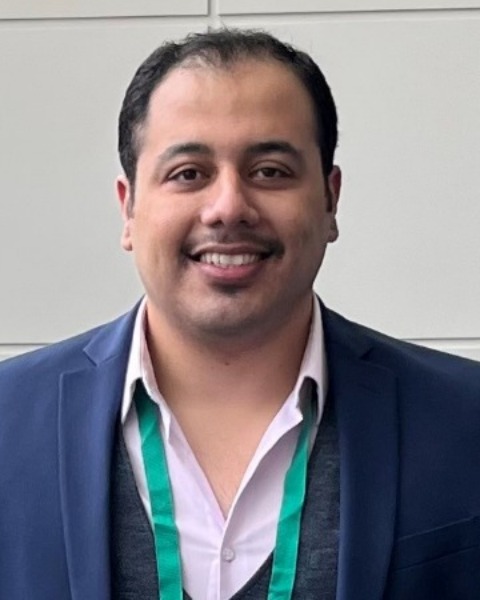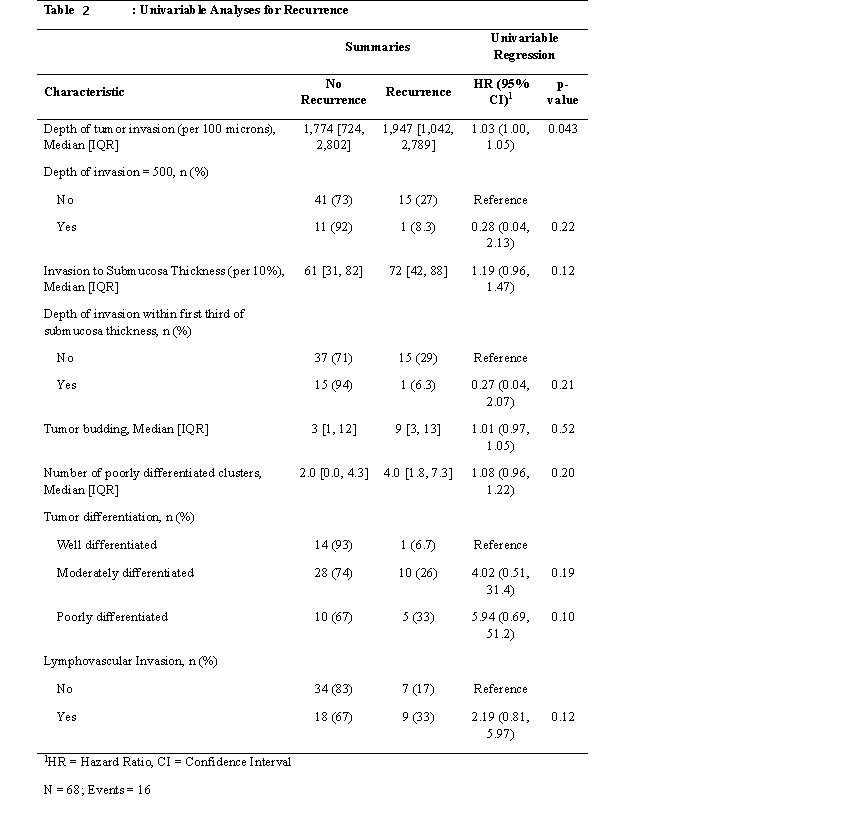Monday Poster Session
Category: Esophagus
P2228 - Investigating the Risk Factors for Recurrence of T1B Esophageal Adenocarcinoma After Esophagectomy: A Long-Term Follow-Up Retrospective Study
Monday, October 28, 2024
10:30 AM - 4:00 PM ET
Location: Exhibit Hall E

Has Audio

Omar Saab, MD
Cleveland Clinic Foundation
Westlake, OH
Presenting Author(s)
Omar Saab, MD1, Xuefeng Zhang, MD2, James Bena, BS2, Siva Raja, MD3, Amit Bhatt, MD4
1Cleveland Clinic Foundation, Westlake, OH; 2Cleveland Clinic Foundation, Cleveland, OH; 3Heart and Vascular Institute, Cleveland Clinic, Cleveland, OH; 4Digestive Disease Institute, Cleveland Clinic, Cleveland, OH
Introduction: T1B esophageal adenocarcinoma (EAC) tumors are confined to the esophageal submucosa and are believed to farewell after surgical resection. Despite being early cancer, recurrence after surgery of have been described. The aim of our study was to investigate risk factors associated with EAC recurrence, after surgical resection, in a cohort with long term follow up.
Methods: We performed a retrospective single center cohort study on 120 consecutive patients who had esophagectomy of pathologically staged T1b EAC, who had not received preoperative chemotherapy or radiation, and had long term follow up data. Patients who underwent esophagectomy between 1988 and 2009 were included. Patient pathology tissue was re-revaluated for this study, and exact depth of submucosal invasion was measured in microns. Factors studied included depth of invasion into submucosa, differentiation grade, tumor budding, and lymphovascular invasion (LVI).
Results: Of 120 patients who under esophagectomy alone for T1b EAC, 68 with follow up data, and available pathologic samples were included in the analysis. The mean follow-up period was 44 months. The patient demographics and surgical details are presented on Table 1. The majority of patients had a thoracotomy approach (n=42, 62%), the median number of lymph nodes removed was 17 (11,27), and all patients had R0 resection. The 30-day mortality after surgery was 2.9% (n=2). Recurrence was seen in 16/68 (24%) of patients. (how many were local and how many were metastatic recurrence). On univariate analysis depth of tumor invasion was statistically associated with tumor recurrence (Table 2).
Discussion: Our findings suggest even after R0 surgical resection of T1b EAC, there remains a significant risk of recurrence. In our study one quarter of patients had recurrence after surgical resection. Depth of submucosal invasion may be a risk factor for recurrence. Long term surveillance is warranted in these patients.

Disclosures:
Omar Saab, MD1, Xuefeng Zhang, MD2, James Bena, BS2, Siva Raja, MD3, Amit Bhatt, MD4. P2228 - Investigating the Risk Factors for Recurrence of T1B Esophageal Adenocarcinoma After Esophagectomy: A Long-Term Follow-Up Retrospective Study, ACG 2024 Annual Scientific Meeting Abstracts. Philadelphia, PA: American College of Gastroenterology.
1Cleveland Clinic Foundation, Westlake, OH; 2Cleveland Clinic Foundation, Cleveland, OH; 3Heart and Vascular Institute, Cleveland Clinic, Cleveland, OH; 4Digestive Disease Institute, Cleveland Clinic, Cleveland, OH
Introduction: T1B esophageal adenocarcinoma (EAC) tumors are confined to the esophageal submucosa and are believed to farewell after surgical resection. Despite being early cancer, recurrence after surgery of have been described. The aim of our study was to investigate risk factors associated with EAC recurrence, after surgical resection, in a cohort with long term follow up.
Methods: We performed a retrospective single center cohort study on 120 consecutive patients who had esophagectomy of pathologically staged T1b EAC, who had not received preoperative chemotherapy or radiation, and had long term follow up data. Patients who underwent esophagectomy between 1988 and 2009 were included. Patient pathology tissue was re-revaluated for this study, and exact depth of submucosal invasion was measured in microns. Factors studied included depth of invasion into submucosa, differentiation grade, tumor budding, and lymphovascular invasion (LVI).
Results: Of 120 patients who under esophagectomy alone for T1b EAC, 68 with follow up data, and available pathologic samples were included in the analysis. The mean follow-up period was 44 months. The patient demographics and surgical details are presented on Table 1. The majority of patients had a thoracotomy approach (n=42, 62%), the median number of lymph nodes removed was 17 (11,27), and all patients had R0 resection. The 30-day mortality after surgery was 2.9% (n=2). Recurrence was seen in 16/68 (24%) of patients. (how many were local and how many were metastatic recurrence). On univariate analysis depth of tumor invasion was statistically associated with tumor recurrence (Table 2).
Discussion: Our findings suggest even after R0 surgical resection of T1b EAC, there remains a significant risk of recurrence. In our study one quarter of patients had recurrence after surgical resection. Depth of submucosal invasion may be a risk factor for recurrence. Long term surveillance is warranted in these patients.

Figure: Table 2: Univariable Analyses for Recurrence
Disclosures:
Omar Saab indicated no relevant financial relationships.
Xuefeng Zhang indicated no relevant financial relationships.
James Bena indicated no relevant financial relationships.
Siva Raja indicated no relevant financial relationships.
Amit Bhatt indicated no relevant financial relationships.
Omar Saab, MD1, Xuefeng Zhang, MD2, James Bena, BS2, Siva Raja, MD3, Amit Bhatt, MD4. P2228 - Investigating the Risk Factors for Recurrence of T1B Esophageal Adenocarcinoma After Esophagectomy: A Long-Term Follow-Up Retrospective Study, ACG 2024 Annual Scientific Meeting Abstracts. Philadelphia, PA: American College of Gastroenterology.
